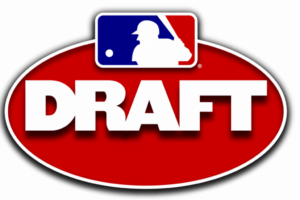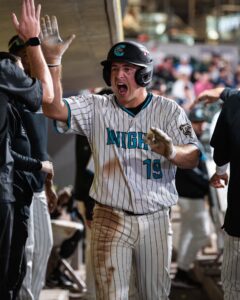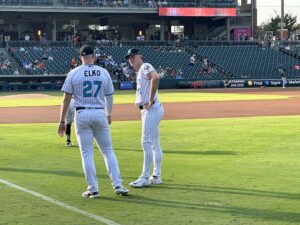State of the System: Corner Infield
Positional Overview:
Last off-season Rick Hahn overhauled the corner infield positions for the Sox by signing Jose Abreu and trading for Matt Davidson. One of those moves turned out spectacularly well, with Abreu proving to be one of the most dangerous hitters in the game. The other move, unfortunately, was far less successful, with Davidson flopping in Triple-A. Conor Gillaspie proved a nice surprise, excelling against RHP to the tune of a .300/.360/.444 line, but his inability to hit lefties will prevent him from being an everyday player, and his defense leaves something to be desired. Gordon Beckham is back and has made a strong start to the season both offensively and defensively, and he should be at least a capable backup. On the prospect front, the corner infield spots look a lot weaker than at this time last year. This is due to Abreu’s graduation, Davidson’s demise, Rangel Ravelo and Andy Wilkins changing organizations and a focus on up-the-middle payers in the 2014 Draft (Ryan Leonards, in the 21st round, was the first corner infielder selected – and he has since transitioned to SS).
Will the Sox miss Rangel Ravelo, and the balance he brought to the prospect lineup?
Ravelo, along with several other players, was sent to Oakland this past offseason as part of the package to acquire Jeff Samardzija. If you look at the top offensive prospects in the system at present, they all have a similar profile; raw and toolsy. Ravelo is the opposite of that. He doesn’t have massive power or elite athleticism, but he does bring a sound approach at the plate. He’s able to make consistent contact (career 13.2 K%), he draws walks (9.1 BB% career, 11.1 BB% over the past two seasons) and he has shown developing power (ISO by season; .077, .107, .134, .164). As an individual prospect, I don’t think he will be missed, but his approach helped to bring some balance to the system. It’s great having exciting, raw, high upside prospects, but a lot of those guys will flame out in the upper minors, and the White Sox don’t have the best track record of developing hitters. Prospects like Ravelo, or Carlos Sanchez, are far less exciting than a Courtney Hawkins, but they are a safer bet to reach their upside, and likely have a better chance of providing some value at the Major League level, and this is something that the White Sox are missing at present.
Top Prospect:
Trey Michalczewski, 3B– Michalczewski had a relatively successful first full season as a pro, hitting .273/.348/.433 at Kannapolis. He showed promising power with a .160 ISO, though that did fall to just .028 in limited action with the Dash. I think it will take him a few years before he starts to fully tap into his raw power potential, but he could be a 20 HR guy in time. He also displayed excellent patience with a BB% of 9.1% in Low-A and 10.7% in High-A, which is encouraging, though tends not to be all that predictive in the lower minors. There main area of concern is with his propensity for striking out. His K% sat at 28.3% with Kannapolis last year, and has never been below 25% at any stop. Trey has always been young for his level though, and has plenty of time to get the strikeouts under control. He has good athleticism and should be an average or better defender at 3rd with a plus arm. Michalczewski’s upside is that of an above average regular.
Best of the Rest:
Keon Barnum, 1B– Barnum is one of the more frustrating prospects in the Sox system. He possesses excellent raw power and has the chance to be an impact bat at the Major League level, but his tools have not yet translated to in-game performance, and his 2014 season was particularly disappointing. He did start last season as a 21 year old in High-A, so was somewhat young for the level, and he has dealt with numerous injuries over his career, but even still, 8 HR and a .112 ISO from a 1B is very poor. To compound the lack of power, Keon also has a lot of trouble making contact, as he struck out in 30.6% of his PA’s last year, and 29.2% for his career. Barnum could be a power hitting 1B with minimal secondary skills at his peak (including below average defense at 1st), but his chance of reaching that upside is quite slim.

Dan Black, 1B/DH– Black continues to be a steady contributor in the Minors, displaying a nice mix of patience, power and contact. Unfortunately he doesn’t have any plus tools and he plays a position at which the offensive requirements are high. He’s a marginal prospect with the upside of a AAAA type bat.
Matt Davidson, 3B– Entering last year as the presumed 3rd baseman of the future for the Sox, Davidson’s season was about as bad as it could have possibly been. His triple-slash line was an anaemic .198/.281/.360. His power, walk rate and contact rate all declined from the previous year, and his 30.3 K% and .162 ISO were the worst of his career. Despite the negatives, he did manage to slug 20 home runs for the fourth year in a row, his 9.0 BB% was still good and he was hurt by an unusually low .250 BABIP (his career MiLB BABIP is .315). If you adjust Davidson’s 2014 line to account for an average BABIP he would have hit somewhere in the region of .265/.345/.425, which doesn’t look so bad. I think there are still reasons for some optimism, but it will be very difficult for him to become an average MLB hitter while striking out in 30% of his plate appearances. To provide some context, there were 15 qualified MLB hitters last year that had a K% above 25%. Of those 15, only 9 of them were average of better hitters (wRC+ of at least 100), and of those 9, the average number of home runs hit was 29, so that gives you an idea of the level of power required to make this approach work. Don’t give up on Davidson just yet, but he still has a lot of work to do.






